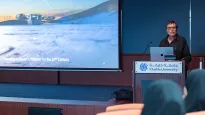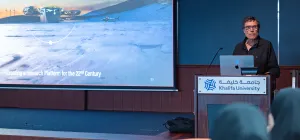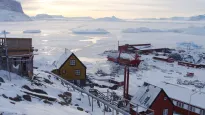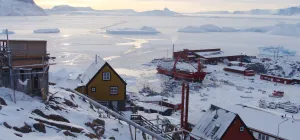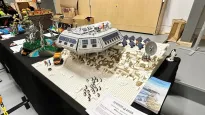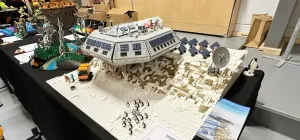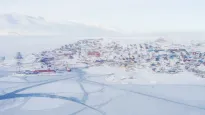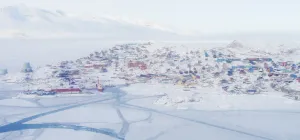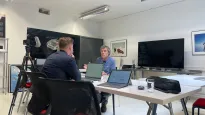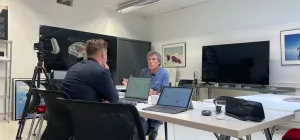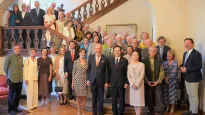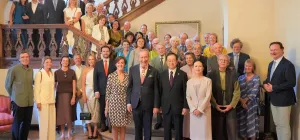Baillet Latour Antarctica Fellowship Laureate presents research at EGU General Assembly

On Thursday 7 May, Dr. Kate Winter from Northumbria University, presented the work she has been doing for the last two seasons at the Princess Elisabeth Antarctica at the European Geosciences Union General Assembly 2020, Europe’s largest annual conference for geoscientists, which was forced to move online this year due to the COVID-19 crisis.
As the 2018-2020 laureate of the Baillet Latour Antarctica Fellowship, Dr. Winter has spent the 2018-2019 an 2019-2020 seasons in Antarctica conducting research for her BioFe project. Her research is examining how bioavailable iron (iron compounds that nourish organisms) is being transported by sediment in glacial ice as it flows from Antarctica’s interior to the coast and ultimately the Southern Ocean. Once in the ocean, this iron nourishes primary producers like phytoplankton, which take in carbon dioxide from the atmosphere as they grow.
Dr. Winter recounted her experience talking about her research at such an import scientific conference.
How did you come to present your research at the 2020 EGU General Assembly?
I submitted an abstract in January, just before I left Cape Town for my second field season at the Princess Elisabeth Antarctica. The EGU General Assembly has lots of different sessions that you can apply to be a part of, so I chose a session about biogeochemical cycling because I wanted to discuss my research with experts in this field.
How did you go about presenting your research at a conference using an online format?
A convener was assigned to manage each of the hundreds of sessions that had been scheduled. Due to the online format of the assembly, my session convener asked those of us presenting to put together a graphical abstract describing the research each of us has been doing, so people taking part in the session could get an idea of what our research was about before the session started.
During the session, which focused on biogeochemical cycling in the cryosphere, each presenter had five minutes to briefly introduce their research before the floor was open to questions.
What did you focus on in your presentation?
I used the session to introduce my research project, focusing on the multi-disciplinary research techniques I use to assess how continental sediments can add to the global carbon feedback loop.
During the session I learnt lots about biogeochemical cycling in the ocean, but I realised that very few people are looking at the source of bioavailable iron, so I am glad that my research will be able to start filling this gap.
Most of the presenters conduct their research in the Northern Hemisphere, in Svalbard and Greenland so it’s great that we are starting to see what is happening in Antarctica. One other researcher was looking at biogeochemical cycling along the coast of an island off the Antarctic peninsula, but it looks like I am one of the first researchers to be searching for nutrients in Antarctica in the interior of the continent. I think that might be due to logistical and cost constraints.
Research projects that go deep into Antarctica require a lot of funding to complete, so I was very lucky to have had the funding from the Baillet Latour Antarctica Fellowship to be able to travel to more remote and logistically challenging parts of Antarctica. My research will allow the scientific community to fill in some of the scientific and geographical gaps of our knowledge of biogeochemical processes.
How was the presentation of your work received?
Very well. A lot of the participants asked about the methodologies that I used in my research, and how I knew that the iron-rich nutrients were coming from the sediment that was previously at the bottom of the ice sheet. I knew this thanks to the radar imaging that I was able to do during the two seasons I was in Antarctica.
The audience really appreciated how interdisciplinary my field research was. I wasn’t just taking sediment samples. I was also using radar to look at the topography of the bedrock beneath the ice, and using drone mapping and seismometers to track how sediment falls off of rocky outcrops and slip below the ice, before the sediment is transported to the coast via glacial flow.
Are you satisfied with how the session turned out?
One of my goals was to interact with researchers studying bioavailable iron that’s already in the ocean (on the other end of the nutrient cycle process) to exchange ideas and network. I was surprised at how well the online conference format worked – I was able to get in touch with a number of researchers who I’ve never met. I now have their contact details, so we can discuss our research further.
I was able to get the contact information of some of them, so we can discuss our research further.
The other session participants were also very helpful. Some of them gave me pointers on how I could begin to look at other nutrients in the sediment samples I collected in Antarctica, whilst others talked about the potential for future research collaborations. This shows how the work I’ve conducted in Antarctica, thanks to the Baillet Latour Antarctica Fellowship, is a great proof of concept, so we could upscale this work in the future, to other areas of Antarctica and Greenland. The more I connect with those in the scientific community who work in this area, the more I get excited about the future – there is still so much to explore!
How many people attended your presentation online?
About 160 participated. This is a lot more than would have been able to fit into the room where we would have presented at the assembly in Vienna.
How did you find the online format of the conference?
I was so pleased that the organisers were able to run the conference online, at such short notice. One positive aspect is that all communication was done via text messages, which helped bring more people into the conversation than you could normally include in person (because of time constraints). There were no video presentations. This format allowed young academics who may sometimes be a bit shy to ask questions. It’s usually the more senior and more confident people who ask questions to presenters at conferences. In this format, everyone got to ask questions, which made it a more enriching experience. No question is silly. An idea you bring up can help move a project forward, so I really hope we can include text message chats and discussions in future conferences (whether they are held online, or in person)
A downside is that if you give a presentation online, sensitive information such as data and preliminary findings that haven’t been peer-reviewed can’t be shared easily (as is often the case at scientific conferences). In a closed-room setting, you’re only presenting to your peers, so you know who you’re talking to. You’ve all been in the same situation at some point so you know your audience will be discreet. But if you present online, you don’t know who might be able to have access to this information, so it’s a bit more restrictive.
I will say that not travelling to and from the conference made for a much smaller carbon footprint for the assembly. The current situation made it possible to test how to hold a conference as large as the EGU General Assembly (which usually draws more than 6,000 people) entirely online, without the massive carbon footprint involved in flying people in from all over the world. Many scientists don’t want to go to conferences all the time because of the environmental impacts of doing so. This was an occasion to test alternatives.
While one downside to online meetings is that you can’t meet people in person and build professional relationships with them, perhaps we don’t need to have in-person conferences as often as we do. Or perhaps we could do more hybrid conferences that are partly online and partly in-person to reduce the amount of travel required. In any case, the EGU General Assembly 2020 paved the way for how we might be able to have more environmentally-friendly conferences in the future.











